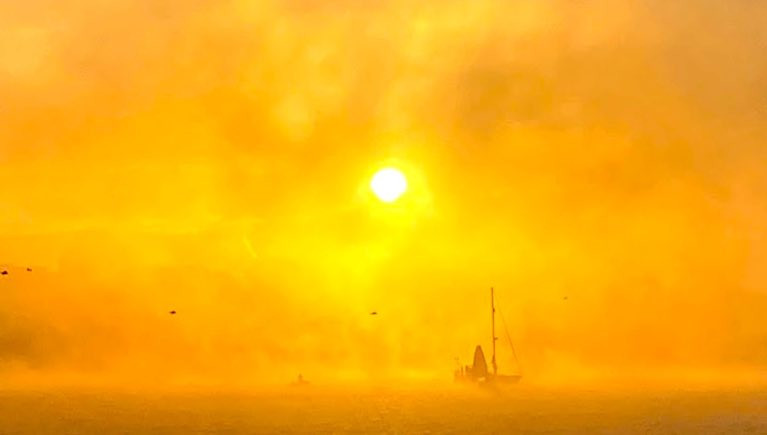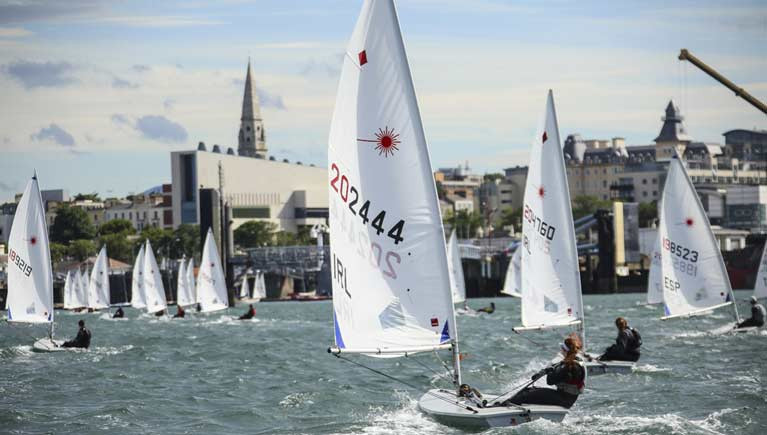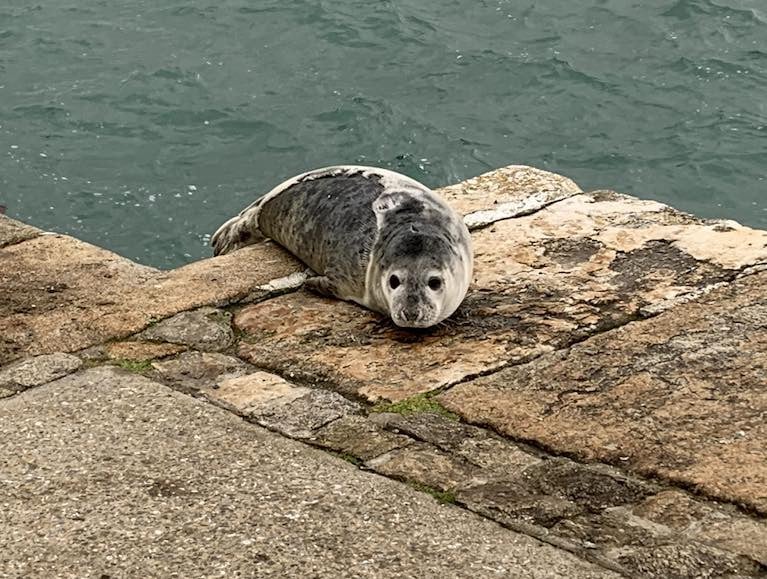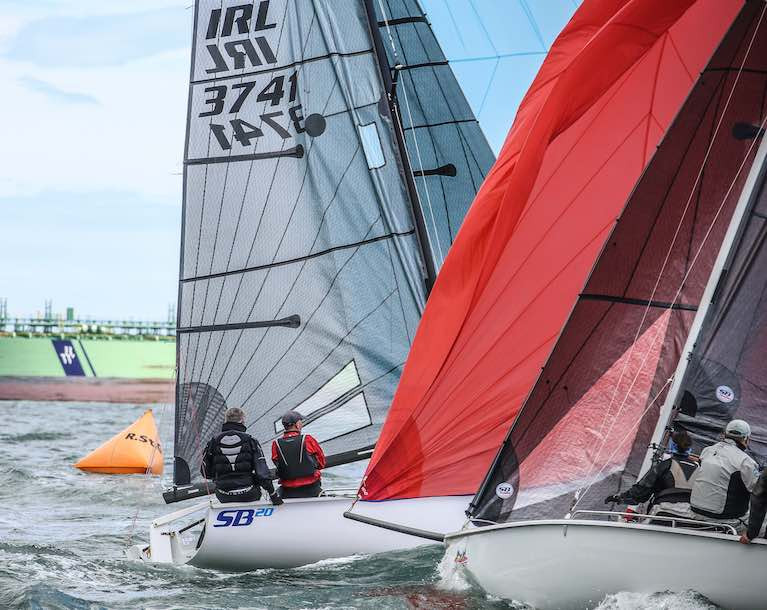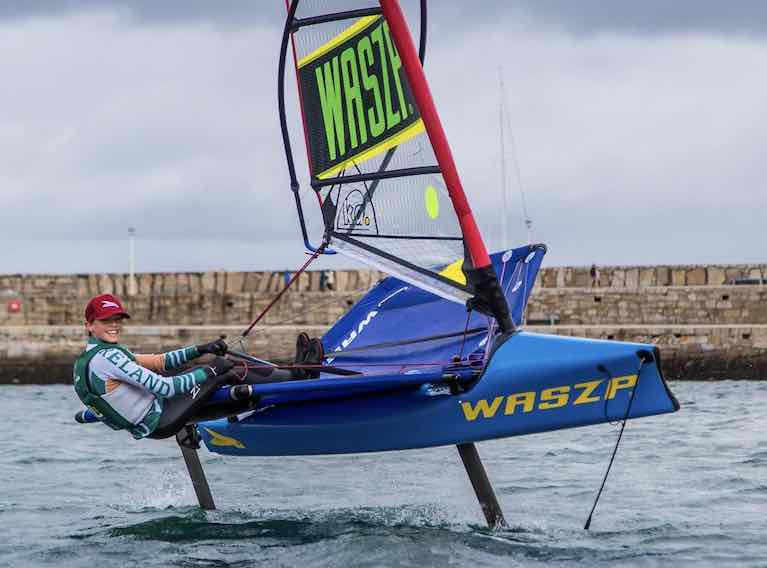Displaying items by tag: Dun Laoghaire Harbour
You will have seen Afloat’s photos (posted this morning) of various training “clinics” emerging into sunshine yesterday in and off Dun Laoghaire harbour as people tried to get in some regulation-compliant sailing after the "ghost season” which seems to have been the tone of much of 2020.
But a harbour as old and history-laden as Dun Laoghaire can serve up real spooks if you know where to look and when, and seasoned sailor Jonathan O’Rourke succeeded in spotting a few ghosts wisping about the place as he took a walk in spectral fog down the East Pier.
Now you see them, now you don’t……..
 Surely they’re real? Photo: Jonathan O’Rourke
Surely they’re real? Photo: Jonathan O’Rourke
 Well, of course, they’re real…….Photo Jonathan O’Rourke
Well, of course, they’re real…….Photo Jonathan O’Rourke
 Are you really really sure? Where are they? And what that’s weird wailing noise…..? Photo: Jonathan O'Rourke
Are you really really sure? Where are they? And what that’s weird wailing noise…..? Photo: Jonathan O'Rourke
Dublin Bay Sea Fog is No Barrier for Dinghy & One Design Keelboat Sailing at Dun Laoghaire Harbour
There was plenty of sailing at Dun Laoghaire Harbour today as Laser, RS Aeros, Toppers and Optimist dinghy fleets enjoyed some great breezes even if a sea-fog reduced visibility for a time even within the harbour confines.
Up to 30 dinghies were afloat at the venue for the ideal 16-knot north-westerly training sessions that also saw the National Yacht Club's Elliot six-metre match racing keelboats on the water as well Flying Fifteens.
The much-anticipated DBSC Turkey Shoot training for cruiser-racers did not take place on the Bay due to COVID-19 restrictions.
 A safety RIB on patrol in Dun Laoghaire Harbour as Optimist dinghies are shrouded in mist
A safety RIB on patrol in Dun Laoghaire Harbour as Optimist dinghies are shrouded in mist
 The scene in nearby Scotsman's Bay with a view of Sandycove Harbour
The scene in nearby Scotsman's Bay with a view of Sandycove Harbour
 Flying Fifteens sailing at Dun Laoghaire Harbour Photo: Chris Doorly
Flying Fifteens sailing at Dun Laoghaire Harbour Photo: Chris Doorly
 Laser and RS Aero dinghies in the winter sunshine and mist at Dun Laoghaire Harbour Photo: Janet Thompson
Laser and RS Aero dinghies in the winter sunshine and mist at Dun Laoghaire Harbour Photo: Janet Thompson
DMYC Launch 'Christmas Cracker' Dun Laoghaire Harbour Dinghy Event
The Dun Laoghaire Motor Yacht Club (DMYC) has its “Christmas Cracker” dinghy series, in anticipation of the amended Level 3 Restrictions due to take effect on 18th December, to give all East Coast dinghy sailors a chance to “pull in their sheets and wear rubber” over the festive season, in anticipation that many sailors will be staying local.
The DMYC is celebrating 50 years of winter sailing organisation this year.
The event will take place on Sundays 20th, 27th and New Year’s Day 1st January, commencing @ 12.00 in the main harbour.
The event is intended for double-handed and solo sailors, with a PY handicap of 1400 or lower.
A Notice of Event and registration system is now live here. Download an event poster below.
The event will be capped at the first 100 entrants. The DMYC's Neil Colin says, "If we cannot go sailing due to the pandemic, the nominal entrance charge will be refunded".
This is an open event, visitors on the days are welcome to use the harbour’s public slipways as well as the regular waterfront slipways, to minimise congregation and maintain safe distancing.
There will be no social “after sail” gatherings, and club changing rooms are expected to be closed. Consequently, a “sail and dash” approach is needed, and even this season’s fashion accessory, the 'Dry Robe' will come in handy.
Dun Laoghaire Harbour Sailing & Boating Boosted by November's Good Weather
November drew to a close with a flurry of boating activity at Dun Laoghaire Harbour on Dublin Bay this weekend with dinghy and cruiser sailors as well as motorboaters, kayakers and swimmers all taking advantage of the mild November conditions ahead of wintry showers forecast for the first week of December.
Anticipating a return to training – as COVID-restrictions lift from Tuesday – there were several different fleets out on the bay making the most of the mild weather, with Saturday harbour numbers equalling those of any summer weekend.
 New arrival - the latest addition to Ireland's biggest leisure boat fleet is in fact a massive Christmas decoration located at the Dun Laoghaire Harbour roundabout
New arrival - the latest addition to Ireland's biggest leisure boat fleet is in fact a massive Christmas decoration located at the Dun Laoghaire Harbour roundabout
In terms of Dublin dinghy sailing, there was plenty of action inside the harbour itself with separate different mini-fleet sessions in operation. These included junior Optimist fleets as well as youth Laser squads. Half a dozen 29er skiffs got some good light airs to practise roll tacks and roll gybes on Sunday morning.
On top of this, there was a number of individual cruiser-racers out on the bay, these were boats that typically would have been part of the postponed DBSC Turkey Shoot Series that normally attracts up to sixty boats at this time of year.
 Calm conditions on Dublin Bay as viewed from the Dun Laoghaire Baths site currently undergoing redevelopment Photo: Afloat
Calm conditions on Dublin Bay as viewed from the Dun Laoghaire Baths site currently undergoing redevelopment Photo: Afloat
The Irish National Sailing School (INSS) boats were also out on the water enjoying both dinghy and keelboat activity.
On the powerboat side, there was a quite a number of RIBs and motorboats enjoying the flat seas for a late run down to Dalkey Island and on Sunday quite a number were anchored in Scotsman's Bay as late as the sunset just after 4 pm.
A single 49er Olympic skiff was out from the Irish Sailing Olympic HQ as Ireland continues to seek the last men's Olympic berth in the skiff class for Tokyo.
Town Marina & Waterfront Yacht Clubs
 Christmas decorations are up at at the National Yacht Club
Christmas decorations are up at at the National Yacht Club
There was constant activity at Dun Laoghaire Marina and waterfront yacht clubs with berth holders checking on boats as the clubhouses prepare for Christmas shoreside activity in keeping with new COVID regs this week. This includes the Royal Irish Yacht Club that will host a member's Christmas Market starting next weekend. The National Yacht Club Christmas lights have gone on, the trees are in place and the Clubhouse decorated to celebrate the season. Most importantly, Commodore Martin McCarthy remains hopeful the clubhouse can welcome members warmly back to dine, have a glass or two and talk about sailing exploits and other matters.
Likewise, at the neighbouring Royal St. George Yacht Club where the winter lift out was completed successfully at the end of October, members celebrated some fine DBSC summer racing performances last week and now deluxe hampers are being prepared for Christmas.
 November's Blue skies and light winds at Dun Laoghaire Marina
November's Blue skies and light winds at Dun Laoghaire Marina
 Cruisers ashore for winter at the Royal Irish Yacht Club
Cruisers ashore for winter at the Royal Irish Yacht Club
Dun Laoghaire Harbour Call in for Ireland-Iceland Rowing Boat Crew
A Greystones County Wicklow-based challenge to row from Ireland to Iceland next Spring made a preliminary call into Dun Laoghaire Harbour last week.
Led by James Murray, the expedition aims to "safely get from Ireland to Iceland under human power alone. No motors, no sails".
The schedule is to set off from Dublin, Ireland in Spring 2021 and for different crew members to join for legs on the way to Iceland.
As Murray explains on his website, row to iceland.com, "each team member has their own reasons for joining, but we all share an appreciation for the beauty of the places in-between and that seemingly extraordinary thing are possible".
Departing Dublin in April, the 3000km route will follow up Ireland's east coast before crossing to Scotland.
Following the Scottish coast, the plan is for the rowing boat to stop into fjords and towns along the way.
The plan then is to cross to the Orkney Islands and Shetland Islands before preparing for the big push to the Faroe Islands and then Iceland.
The trip is expected to take three to six months
Murray also asks on the campaign website that if you have experience with part of this route "we'd love to hear from you to help inform our plans".
Seal Pup Hauls Out at Dun Laoghaire Harbour
This inquisitive Dublin Bay young seal made his way up the steps of Dun Laoghaire's East Pier much to the surprise of weekend harbour strollers.
Harbour and grey seals have a year-round presence at Dun Laoghaire and Dublin Bay in general.
The seals often haul-out on man-made structures and tolerate considerable human activity but it's unusual to see a pup on its own on the East Pier.
Such sites are used during breeding, moulting, resting between foraging trips in the open sea, and to engage in social activity.
Under the Wildlife Acts 1976 to 2018, cetaceans and seals are protected species.
The Irish Sea Sanctuary says if you encounter seals ashore "the GOLDEN RULE…..is give them space and observe from a distance".
Seals and getting to the truth about shooting them was the subject of a recent podcast by Afloat's Tom MacSweeney here.
Dinghy, One Design & Cruiser Class Championships Sign Up for Volvo Dun Laoghaire Regatta 2021
Preparations for Volvo Dun Laoghaire Regatta 2021 next July on Dublin Bay are off to a flying start with nine of the expected 22 racing classes already declaring regional or national championships to be held as part of the biennial sailing festival.
It has been confirmed that Dragons will race for national honours and so will Beneteau 211s, Beneteau 31.7s and Shipmans.
As regular Afloat readers will know, in order to facilitate social distancing and be Covid-19 compliant, a new regatta format will comprise a One Design Championship (2nd – 4th July 2021) specifically tailored for sailors in the one-design keelboat and dinghy classes. This is to be followed by an Open Cruiser Championship (8th – 11th July 2021) catering for the full range of Cruiser Handicap classes.
 The Dublin Bay-based Shipman keelboat class will sail for national championship honours as part of Volvo Dun Laoghaire Regatta 2021 Photo: Afloat
The Dublin Bay-based Shipman keelboat class will sail for national championship honours as part of Volvo Dun Laoghaire Regatta 2021 Photo: Afloat
The special changes, announced in September, have been met with a strong seal of approval from competitors with the following early adopters:
- Beneteau 211 National Championships
- Beneteau 31.7 – National Championships
- Shipman – National Championships
- GP14 – Leinster Championships
- Fireball Leinster Championships
- Dragon – Irish National Championship
- SB20 Western Championships
- RS200 Leinster Championships
- RS400 Leinster Championship
 The Beneteau 211s will also race for National Championship honours Photo: Afloat
The Beneteau 211s will also race for National Championship honours Photo: Afloat
Royal Dee ISORA Championships
In addition, in the cruiser classes, the Royal Dee Irish Sea Offshore Championship will be held as part of VDLR 2021. These offshore races will be held together with the Lyver Trophy Race from Liverpool to Dun Laoghaire on Friday 1st July 2021, to make it a highlight of next year's Irish Sea Offshore (ISORA) season.
 ISORA racing will be incorporated into Volvo Dun Laoghaire Regatta 2021
ISORA racing will be incorporated into Volvo Dun Laoghaire Regatta 2021
It's a satisfying early result for the VDLR Committee under Chairman Don O'Dowd who meets again with his committee tonight to finalise the Notice of Race document due for release shortly.
Meeting the COVID-19 challenges in 2021
Dun Laoghaire is unique in being able operate in this pandemic because of the extensive area within the harbour site and facilities provided by the waterfront clubs and organisations. The Regatta will utilise the full infrastructure of Dun Laoghaire Harbour venue to the best advantage and bring certainty to a calendar that has been hugely dictated by Covid-19 and the constraints imposed due to social distancing.
Charlie Cullen Just Pipped for WASZP Big Prize
Irish WASZP youth sailor Charlie Cullen was pipped by an Australian Olympic sailor for first prize in last weekend's climax of the Global GPS Racing Dinghy Series.
The Dun Laoghaire Harbour skiff sailor was in pole position to win the first prize of two spectator tickets to a Sail GP event and a ride on an F50 catamaran but canny Australian Brad Devine pipped him to the post right on the event deadline.
The first-year Trinity College Dublin Engineering student made a real stab of juggling his studies and the big waves on Dublin Bay to try and win the world challenge and very nearly did.
More here
Dun Laoghaire Harbour Laser Dinghy Class Thank DBSC Race Officer Team
It’s no secret that the Dun Laoghaire Harbour Laser fleet is in good shape. Anybody strolling the piers or looking out on club forecourts will have seen that for themselves. DBSC (Dublin Bay Sailing Club) in 2020 drew a huge entry of 92 Laser 4.7s, Radials and Standards, with regular turnouts of 60-70 boats, with sailors of all ages. Likewise, numerous pods go out training once or twice a week, sharpening race skills and getting newer or returning sailors up to scratch for the real deal.
Everybody in this local Laser community just gets on with it in a great spirit of co-operation and camaraderie. We will get the sailors on the water for racing, but that’s where experienced DBSC Race Officer Suzanne McGarry steps in, aided by a wonderful flagship team. DBSC delivered a wonderful programme from late June to mid September, despite all the challenges of this annus horribilis. Until Level 3 kicked in, organizers squeezed in 24 great Saturday Laser races, as well as a comprehensive Tuesday night series. The funny thing now as we all reflect is that many of us can’t remember a more enjoyable sailing season, even with no showers, outdoor changing at times and all the very necessary protocols. I suppose it was all about local sailing again and people got into a really nice rhythm, uninterrupted by regattas, Championships or foreign holidays! The class captains for the last six years were, therefore, delighted to meet Suzanne at the RStGYC yesterday to present a token of our appreciation for her and the whole team. She went to great lengths to explain about the importance and dedication of everybody involved in the race management team and it’s striking so many have worked together for so many years.
It was in 2015 that Lasers really came out from the shadows in Dun Laoghaire after the fleet had dwindled to 3 or 4 stalwarts, by then subsumed into the Mixed PY division. DBSC had the foresight to listen, giving us our own class again, more shorter races and low entry fees (especially for Under 25s). We were immediately up over 30 boats by 2015 and we’ve basically added 10 regular racers each season since then, even more this year with the push into solo sailing.
 Tuesday DBSC night Laser racing in 2020 Photo: Rob Walker
Tuesday DBSC night Laser racing in 2020 Photo: Rob Walker
Excellent race management has been a massive contribution to the growth of the class. We estimate that Suzanne has presided over more than 80% of the hundreds of races staged in the last six years. Start lines are square, beats and runs are true and results are gathered efficiently. But remember, we’re talking about very tricky conditions here. Racing is within the shifty confines of our wonderful harbour, or outside in Scotsman’s Bay, often in a fickle evening breeze, with a strong tide. Despite being in that characteristic, steely “zone” up on the foredeck, Suzanne is very approachable and receptive to feedback onshore. Indeed, this season, after only a few races, she quickly introduced an innovative tweak to the starting procedure, to give the big Radial fleet more time to digest course changes between races. Incidentally, the 53 boat Laser Radial entry is almost definitely the largest local racing Radial fleet in the world, just now.

The 2020 season was an amazing effort by all DBSC Officers and volunteers. Suzanne and her team got dinghies out competing on June 30th as Afloat reported here. This was at the earliest possible opportunity given government guidelines and well before DBSC keelboat racing started.
Undoubtedly, the Laser turnout that day of 60 boats was the biggest one-design racing staged anywhere in Ireland since the Pandemic began. We hope we encouraged others up and down the country.
From all Dun Laoghaire Laser sailors, thank you, Suzanne and colleagues, for all your support and service down the years.
Below are the names of the core people who help Suzanne and keep the show on the road;
Barbara Conway. Ros Bremner. Caroline Liddy. Brendan Dalton, Declan Traynor, Dara Traynor, James Traynor, Dave Coleman, Liz Aylmer, Sharon Moylan, Ian Mathews, Ben Mulligan, Niki Wheatley, Susan Spain, Caitriona O’Brien Michael Costelloe and Joanne Sheehan
Dun Laoghaire RNLI Launch to Assist Four People Onboard a 36ft Yacht
The Dun Laoghaire Harbour RNLI all-weather lifeboat was launched this afternoon (Saturday 10 October) following a request from the Irish Coast Guard to assist four people on board a 36ft yacht, which had reported having mechanical issues while anchored just off Hawks Cliff in Dalkey.
The all-weather lifeboat was launched at 2:25 pm under Coxswain Mark McGibney with six crew members onboard and made its way to the scene arriving at 2:35 pm. The all-weather lifeboat took the vessel in tow and made its way back to Dun Laoghaire Harbour. While in tow it was reported that the vessel was taking on a significant amount of water and the issue found was resolved before continuing. Arriving in Dun Laoghaire Harbour the lifeboat crew used the lifeboats on board salvage pump to remove the excess water from the yacht before returning to the lifeboat station.
All onboard were wearing lifejackets and no medical attention was required.
Weather conditions at the time were described as good with a light wind and good visibility.
Speaking following the call out, Mark McGibney, Dun Laoghaire RNLI lifeboat Coxswain said: ‘The casualties did the correct thing today by calling for help and keeping themselves safely at anchor until our crew arrived on scene, what happened can happen to anyone and I would like to take this opportunity to remind everybody to make sure that their vessel engines and safety equipment are checked and in working order before taking to the water.’


























